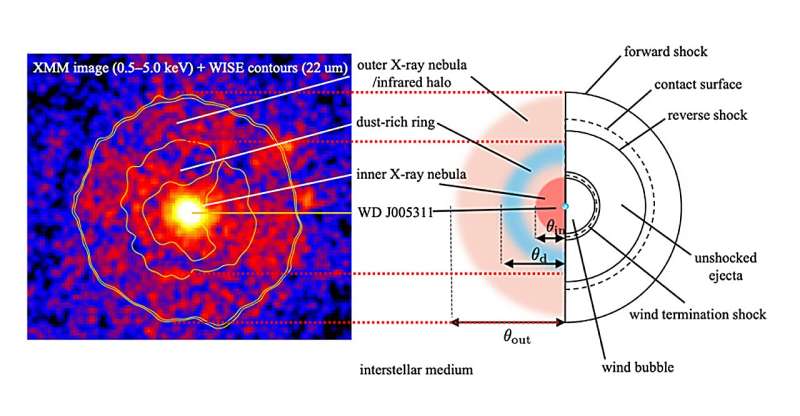
These images show the two shock regions of the remnant SNR 1181. The bright white at the center is a white dwarf. Credit: 2024 d. Koh, H. Suzuki, K. Kashiyama et al./ The Astrophysical Journal
A mysterious remnant from a rare supernova recorded in 1181 has been described for the first time. Two white dwarf stars collided to form a temporary „guest star,” now named supernova (SN) 1181, which has been recorded in historical documents in Japan and elsewhere in Asia. However, after the star dimmed, its location and structure remained a mystery until a team pinpointed its location in 2021.
Now, through computer modeling and observational analysis, researchers have reconstructed the structure of the surviving white dwarf, a rare phenomenon that explains its double shock formation. They also discovered that a high-velocity stellar wind may have started blowing off its surface within the last 20-30 years. Work is done Published Inside The Astrophysical Journal.
The discovery advances our understanding of the diversity of supernova explosions and highlights the benefits of interdisciplinary research, combining history with modern astronomy to enable new discoveries about our galaxy.
It was 1181 and the Genbei War (1180-85) had just begun in Japan. This would lead to a transfer of political power from aristocratic families to a new military-based shogunate, which would establish itself in the coastal city of Kamakura near modern-day Tokyo.
A record of this tumultuous period was compiled in the form of a diary in Asuma Kagami. It describes not only people’s lives and major events (with varying degrees of accuracy), but also other daily observations, including the appearance of a new star.
„Historical records from Japan, China, and Korea contain many accounts of this temporary guest star. At its peak, the star’s brightness was comparable to that of Saturn. It was visible to the naked eye for 180 days, until it gradually faded. The remnant of the SN 1181 explosion is now very old, so it is dark and hard. exists,” explained Takatoshi Ko, a doctoral student in the Department of Astronomy at the University of Tokyo.
The remnant of this guest star, named Supernova Remnant (SNR) 1181, was found to have been formed by the collision of two very dense, Earth-sized stars known as white dwarfs. It produced a rare type of supernova, known as a Type Iax supernova, which left behind a single, bright and rapidly rotating white dwarf. With the help of observations of its position noted in the historical document, modern astrophysicists finally pinpointed its location in a nebula towards the Cassiopeia constellation in 2021.

This diagram illustrates the evolution of the SNR 1181 remnant, from its formation to the formation of its two shock regions, when a carbon-oxygen-based white dwarf and an oxygen-neon white dwarf merged. Credit: 2024 d. Co
Due to its rarity and location in our galaxy, SNR 1181 has been the subject of much observational research. This suggests that SNR 1181 is composed of two shock regions, an outer region and an inner region. In this new study, the research team analyzed recent X-ray data to develop a theoretical computer model to explain these observations, and it recreated the previously unexplained structure of this supernova remnant.
Conventionally, when two white dwarfs collide like this, the main challenge is to make them explode and disappear. However, this merger left behind a white dwarf. A rotating white dwarf was expected to produce a stellar wind (fast stream of particles) soon after its formation. However, the researchers discovered something else.
„If the wind started immediately after SNR 1181 formed, we would not be able to reproduce the observed size of the inner shock region,” Ko said.
„However, by treating the wind onset time as a variable, we succeeded in unraveling the mysterious properties of this high-speed wind, accurately explaining all the observed features of SNR 1181. We were able to track the time evolution of each shock simultaneously, using numerical calculations, in part.”
According to their calculations, the team was surprised to find that the wind could have started blowing very recently, within the last 20-30 years. They suggest that the white dwarf may have started burning again, as some of the material ejected by the 1181 eruption fell to its surface, increasing its density and temperature to a threshold and resuming burning.
To validate their computer model, the team is preparing further observations of SNR 1181 using the Very Large Array (VLA) radio telescope in central New Mexico, USA, and the 8.2-meter Subaru Telescope in Hawaii, USA. .
„The ability to determine the age of supernova remnants or the brightness at the time of their explosion from archaeological observations is a rare and invaluable asset for modern astronomy,” Ko said. „Such interdisciplinary research is exciting and highlights the enormous potential of connecting different disciplines to discover new dimensions of astronomical phenomena.”
More information:
Takatoshi Ko et al., A dynamical model for IRAS 00500+6713: the double degenerate merger product WD J005311 from the Ajax supernova SN 1181-type remnant, The Astrophysical Journal (2024) DOI: 10.3847/1538-4357/ad4d99
Quotation: Elusive temporary star described in historical documents recreated using new computer model (2024, July 5) Retrieved July 5, 2024 from https://phys.org/news/2024-07-elusive-temporary-star-historical-documents.html Received.
This document is subject to copyright. No part may be reproduced without written permission except for any reasonable manipulation for the purpose of personal study or research. Content is provided for informational purposes only.

„Oddany rozwiązywacz problemów. Przyjazny hipsterom praktykant bekonu. Miłośnik kawy. Nieuleczalny introwertyk. Student.
